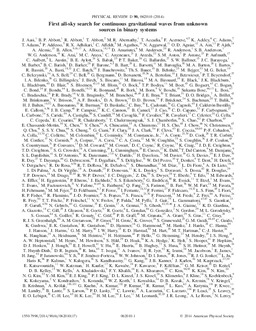| dc.contributor.author | LIGO Scientific Collaboration | |
| dc.contributor.author | Virgo Collaboration | |
| dc.contributor.author | Maglione, C. | |
| dc.contributor.author | Quiroga, C. | |
| dc.contributor.author | Aasi, J. | |
| dc.date.accessioned | 2022-10-13T18:37:49Z | |
| dc.date.available | 2022-10-13T18:37:49Z | |
| dc.date.issued | 2014 | |
| dc.identifier.uri | http://hdl.handle.net/11086/28942 | |
| dc.description | Paper producido por "The LIGO Scientific Collaboration and the Virgo Collaboration". (En el registro se mencionan solo algunos autores de las decenas de personas que participan). | es |
| dc.description.abstract | We present the first results of an all-sky search for continuous gravitational waves from unknown
spinning neutron stars in binary systems using LIGO and Virgo data. Using a specially developed analysis
program, the TwoSpect algorithm, the search was carried out on data from the sixth LIGO science run and
the second and third Virgo science runs. The search covers a range of frequencies from 20 Hz to 520 Hz, a
range of orbital periods from 2 to ∼2; 254 h and a frequency- and period-dependent range of frequency
modulation depths from 0.277 to 100 mHz. This corresponds to a range of projected semimajor axes of the
orbit from ∼0.6 × 10−3 ls to ∼6; 500 ls assuming the orbit of the binary is circular. While no plausible
candidate gravitational wave events survive the pipeline, upper limits are set on the analyzed data. The most
sensitive 95% confidence upper limit obtained on gravitational wave strain is 2.3 × 10−24 at 217 Hz,
assuming the source waves are circularly polarized. Although this search has been optimized for circular
binary orbits, the upper limits obtained remain valid for orbital eccentricities as large as 0.9. In addition,
upper limits are placed on continuous gravitational wave emission from the low-mass x-ray binary Scorpius
X-1 between 20 Hz and 57.25 Hz. | en |
| dc.description.uri | http://journals.aps.org/prd/abstract/10.1103/PhysRevD.90.062010 | |
| dc.format.medium | Impreso; Electrónico y/o Digital | |
| dc.language.iso | eng | es |
| dc.rights | Attribution-NonCommercial-NoDerivatives 4.0 International | * |
| dc.rights.uri | http://creativecommons.org/licenses/by-nc-nd/4.0/ | * |
| dc.source | ISSN 2470-0010 | |
| dc.subject | Gravitational waves | en |
| dc.subject | Bynary systems | en |
| dc.subject | LIGO | en |
| dc.subject | Virgo | en |
| dc.title | First all-sky search for continuous gravitational waves from unknown sources in binary systems | en |
| dc.type | article | es |
| dc.description.version | publishedVersion | es |
| dc.description.fil | Fil: Maglione, C. Universidad Nacional de Córdoba. Facultad de Matemática, Astronomía y Física; Argentina. | es |
| dc.description.fil | Fil: Maglione, C. Argentinian Gravitational Wave Group; Argentina. | es |
| dc.description.fil | Fil: Quiroga, C. Argentinian Gravitational Wave Group; Argentina. | es |
| dc.description.fil | Fil: Aasi, J. LIGO. California Institute of Technology; Estados Unidos de América. | es |
| dc.journal.country | Estados Unidos | es |
| dc.journal.editorial | American Physical Society | en |
| dc.journal.number | 6 | es |
| dc.journal.referato | Con referato | |
| dc.journal.title | Phys. Rev. D | en |
| dc.journal.volume | 90 | es |
| dc.description.field | Física de Partículas y Campos | |
| dc.identifier.doi | http://dx.doi.org/10.1103/PhysRevD.90.062010 | |





